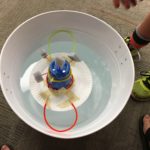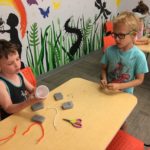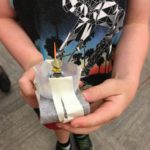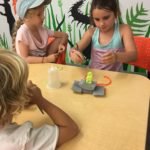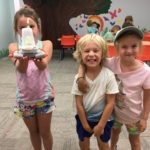Biomimicry at the Insectarium
The world of arthropods is one rich in opportunities for the study of biomimicry. Did you know that there are high rise apartment buildings with passive cooling systems inspired by termite mounds? What about rain coats inspired by butterfly wings? Or how about earthquake building materials created after careful consideration of the legs of walking sticks? Here at the Insectarium we are harnessing the wild world of bugs to help teachers meet the first grade science standard of teaching biomimicry.
Program Description: Biomimicry is what happens when humans design inventions based off inspiration from the natural world. Many of the species of Bug Ambassadors we have here at the Insectarium have inspired human inventions. During this program students will learn about biomimicry via the inventions inspired by our arthropods and have the chance to employ the Engineering Design Process to build a prototype of an invention inspired by either a water strider or a cockroach.
Program Overview:
15 minutes: Welcome and short biomimicry introduction
30 minutes: Exploring in the Insectarium exhibit area
10 minutes: Butterfly wing mini-experiment
35 minutes: Biomimicry engineering challenge
This engineering challenge is the heart of the program. While in the exhibit area students will observe a live arthropod, either a roach or a water strider, and will document their observations via drawing and writing in Observation Journals. Once back in the classroom the class will share what they observed and work together to think of ideas for inventions inspired by the forms and structures that they observed. Through a guided discussion the class will land on an idea and be broken up into teams. These teams of 3 or 4 students will work together to develop a prototype of the invention and test it out together. There will be time for improving their idea. The program wraps up with a class wide discussion of what worked and didn’t work in their designs, as well as ideas for future inventions and how they can transfer these skills into other projects.
Teacher Resources: All teachers coming for a field trip will get a chaperone guide as well as pre and post visit lessons.
Grade Levels: Great for 1st grade teachers looking to tackle the Biomimicry science standard. Can be scaled up for grades 2 – 5 as well and is great for small schools with combined classrooms.
Number of Students: 20 – 30 (larger groups can be accommodated via a “double header” schedule, see details below)
Duration: 1.5 hours
Science Standards:
1-LS1-1: Use materials to design a solution to a human problem by mimicking plant and animal structures and functions that help them survive, grow and meet their needs.
1-LS1-2: Read texts and use media to determine patterns in behavior of parents and offspring that help offspring survive.
K-2-ETS1-2: Develop a simple sketch, drawing, or physical model to illustrate how the shape of an object helps it function as needed to solve a given problem.
Cost: The base cost for a field trip is $40, which covers up to 10 students. Each additional student is $4. We strongly recommend at least 1 adult chaperone per 10 children and these chaperones are free. Adults beyond that 1:10 ratio are $4 each. For homeschooling groups the lead coordinating chaperone is free of charge, all other adults and students participating in the program will be charged $4.
Scheduling & Logistics: The Insectarium runs programs Monday through Friday. We can do programs as early as 10am normally, earlier in a pinch if your schedule is extra tight. If you have more than 30 students in your group we will work with you to come up with a logistical solution. In the past groups of 50 to 60 students (whole grade levels) have had half the group come in the morning while the other half visits the public library, park or other space downtown. After breaking for lunch midday the groups flip-flop and the second half of the students visit with us in the afternoon. We need at least 30 minutes between programs to reset the classroom and are more than happy to help work out all of the scheduling details with you. Email Carolyn Taber any and all logistical and programmatic questions: carolyn@missoulabutterflyhouse.org
Starting with the 2019/2020 school year the Insectarium will be offering a biomimicry program that comes into Missoula area classrooms. This program will feature a classroom visit with the opportunity to expand to additional visits and a trip to a local park or open space area. To stay informed about this new program, join our newsletter mailing list by filling in the short form on the right hand side of this page.
Want to join us for a program? Fill out the short form below to get started.


